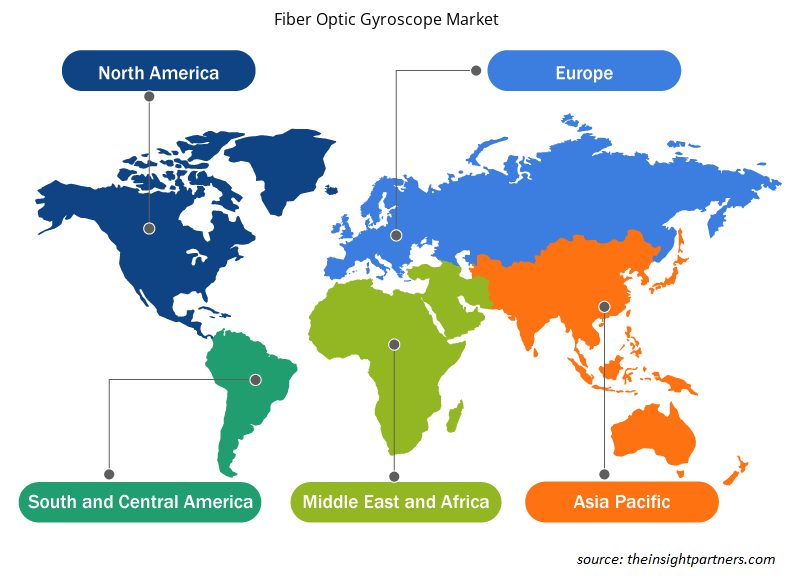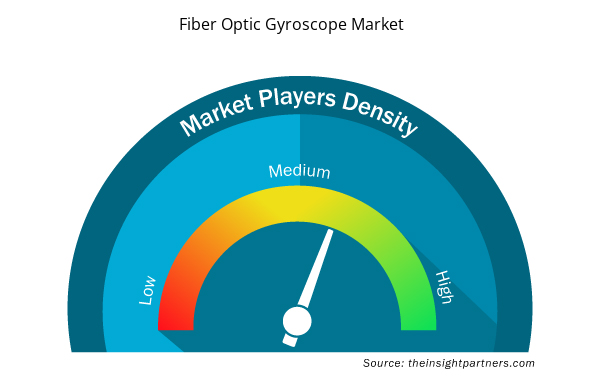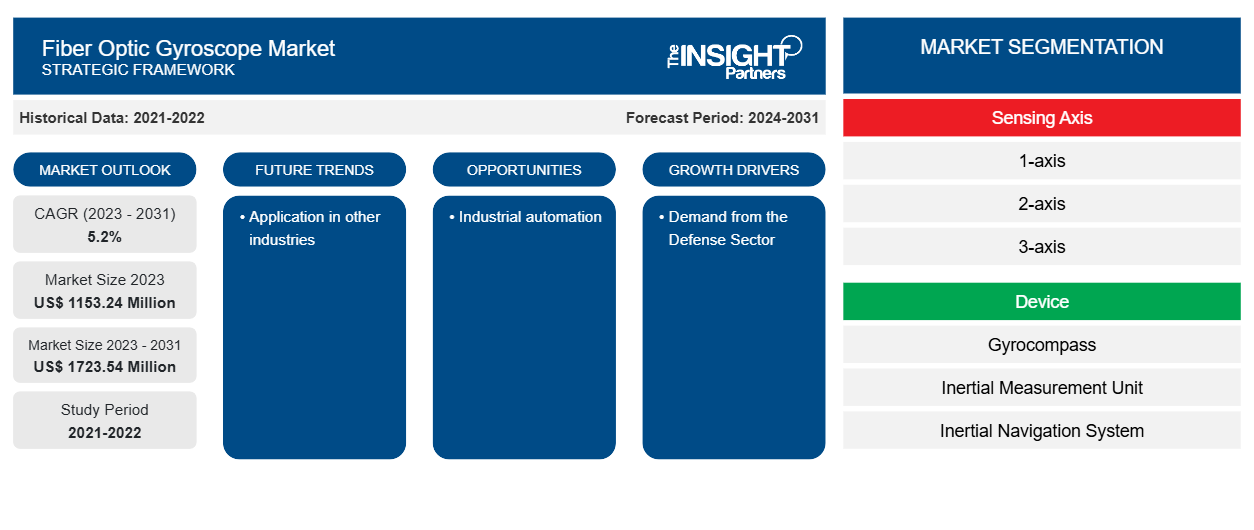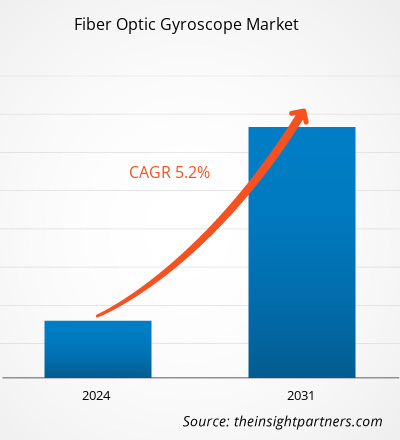Der Markt für faseroptische Gyroskope soll von 1.153,24 Millionen US-Dollar im Jahr 2023 auf 1.723,54 Millionen US-Dollar im Jahr 2031 anwachsen. Der Markt soll zwischen 2023 und 2031 eine durchschnittliche jährliche Wachstumsrate (CAGR) von 5,2 % verzeichnen. Der Anstieg der Militärausgaben und die Vorteile, die faseroptische Gyroskope bieten, werden voraussichtlich weiterhin die wichtigsten Trends auf dem Markt für faseroptische Gyroskope bleiben.
Marktanalyse für faseroptische Gyroskope
Aufgrund der zahlreichen Vorteile von Glasfaser-Gyroskopen, wie z. B. geringe Größe, geringes Gewicht, geringer Stromverbrauch, lange Lebensdauer, hohe Zuverlässigkeit und Massenproduktion, werden Glasfaser-Gyroskope in verschiedenen Branchen wie der Luft- und Raumfahrt, der Verteidigung, in Industriezweigen und anderen nachgefragt. Somit fördert die Nachfrage aus verschiedenen Branchen das Marktwachstum. Darüber hinaus treibt das weltweite Wachstum der Militärausgaben aufgrund der Konzentration der Regierung auf die Stärkung ihres Militärsektors die Nachfrage nach Glasfaser-Gyroskopen in ferngesteuerten Fahrzeugführungsanwendungen an.
Marktübersicht für faseroptische Gyroskope
Ein Glasfaser-Gyroskop wird zur Messung der Winkelgeschwindigkeit verwendet und kommt in verschiedenen Anwendungen zum Einsatz, von der Raketennavigation bis zur Bewegungssteuerung. Glasfaser-Gyroskope haben gegenüber anderen Gyroskoptypen mehrere Vorteile, darunter geringes Gewicht, geringe Größe, lange Lebensdauer, geringer Stromverbrauch, hohe Zuverlässigkeit und Massenproduktion. Für die Navigation, Lenkung und Steuerung von Raketen, Flugzeugen, Robotern, Autos, Raumfahrzeugen usw. ist es ein besonders wichtiges Werkzeug.
Passen Sie diesen Bericht Ihren Anforderungen an
Sie erhalten kostenlos individuelle Anpassungen an jedem Bericht, einschließlich Teilen dieses Berichts oder einer Analyse auf Länderebene, eines Excel-Datenpakets sowie tolle Angebote und Rabatte für Start-ups und Universitäten.
- Holen Sie sich die wichtigsten Markttrends aus diesem Bericht.Dieses KOSTENLOSE Beispiel umfasst eine Datenanalyse von Markttrends bis hin zu Schätzungen und Prognosen.
Markttreiber und Chancen für faseroptische Gyroskope
Nachfrage der Marktteilnehmer aus dem Verteidigungssektor begünstigt den Markt
Mehrere Vorteile von Glasfaserkreiseln, darunter eine hohe Rotationsgeschwindigkeit und eine hohe Auflösung im Vergleich zu ihren Ersatzprodukten, wie etwa Alternativen wie mechanischen Kreiseln und Ringlaserkreiseln, begünstigen ihre Verbreitung im Verteidigungssektor. Aufgrund dieser Vorteile erhalten die Marktteilnehmer Aufträge, die den Markt für Glasfaserkreisel fördern. So gab KVH Industries, Inc. (Nasdaq: KVHI) im August 2021 bekannt, dass es einen Auftrag über 7,9 Millionen US-Dollar für Glasfaserkreisel (FOG) von Escribano, einem spanischen Verteidigungsunternehmen, für seinen neuen ferngesteuerten Geschützturm Guardian 30 erhalten hat.
Anwendung in anderen Branchen – Eine Chance auf dem Markt für faseroptische Gyroskope
Faseroptische Gyroskope wurden ursprünglich für militärische und Verteidigungszwecke entwickelt. Aufgrund ihrer potenziellen Vorteile gegenüber anderen Gyroskoptypen werden sie jedoch auch in anderen Branchen, darunter in kommerziellen und industriellen Sektoren weltweit, häufig eingesetzt. Auch in der Automobil-, Medizin- und Roboterindustrie besteht eine starke Nachfrage nach faseroptischen Gyroskopen. Die steigende Nachfrage nach technologisch fortschrittlichen Lösungen zur Verbesserung der Betriebseffizienz in mehreren Branchen und der wachsende Trend zur industriellen Automatisierung treiben die Nachfrage nach faseroptischen Gyroskopen weiter an.
Segmentierungsanalyse des Marktberichts für faseroptische Gyroskope
Wichtige Segmente, die zur Ableitung der Marktanalyse für faseroptische Gyroskope beigetragen haben, sind Sensorachse, Gerät und Anwendung.
- Basierend auf der Sensorachse ist der Markt in 1-Achsen, 2-Achsen und 3-Achsen segmentiert. Das 3-Achsen-Segment hatte im Jahr 2023 einen größeren Marktanteil.
- Nach Geräten ist der Markt in Kreiselkompass, Trägheitsmesseinheit, Trägheitsnavigationssystem und Lagereferenzsystem unterteilt. Das Segment der Trägheitsmesseinheit hatte im Jahr 2023 den größten Marktanteil.
- Nach Anwendung ist der Markt in taktische Anwendungen, ferngesteuerte Fahrzeugführung, Luft- und Raumfahrt, Robotik sowie Verteidigung und Heimatschutz unterteilt. Das Segment Verteidigung und Heimatschutz hatte im Jahr 2023 den größten Marktanteil.
Marktanteilsanalyse für faseroptische Gyroskope nach geografischer Lage
Der geografische Umfang des Marktberichts für faseroptische Gyroskope ist hauptsächlich in fünf Regionen unterteilt: Nordamerika, Asien-Pazifik, Europa, Naher Osten und Afrika sowie Südamerika/Süd- und Mittelamerika.
Gemessen am Umsatz hatte Nordamerika im Jahr 2023 den größten Marktanteil bei faseroptischen Gyroskopen. Der asiatisch-pazifische Raum dürfte im Prognosezeitraum mit der höchsten CAGR wachsen.
Der anhaltende Drang der Streitkräfte nach neuen Technologien für Kampf- und Nichtkampfeinsätze treibt die Verteidigungsausgaben in Nordamerika in die Höhe. Nach Angaben des Stockholmer Friedensforschungsinstituts (SIPRI) erreichten die Militärausgaben der USA, des weltweit größten Militärausgabenträgers, im Jahr 2022 877 Milliarden US-Dollar, was 39 Prozent der gesamten globalen Militärausgaben entspricht und dreimal mehr ist als der Betrag, den China, der weltweit zweitgrößte Militärausgabenträger, ausgibt. Solche Militärausgaben führen zu einer Nachfrage nach fortschrittlicher Technologie für zuverlässige und genaue Navigationssysteme in Flugzeugen und Raketen, was wiederum Glasfaserkreisel erfordert, da diese eine höhere Genauigkeit bieten.
Regionale Einblicke in den Markt für faseroptische Gyroskope
Die regionalen Trends und Faktoren, die den Markt für Glasfasergyroskope im Prognosezeitraum beeinflussen, wurden von den Analysten von Insight Partners ausführlich erläutert. In diesem Abschnitt werden auch die Marktsegmente und die Geografie von Glasfasergyroskopen in Nordamerika, Europa, im asiatisch-pazifischen Raum, im Nahen Osten und Afrika sowie in Süd- und Mittelamerika erörtert.

- Erhalten Sie regionale Daten zum Markt für faseroptische Gyroskope
Umfang des Marktberichts über faseroptische Gyroskope
| Berichtsattribut | Details |
|---|---|
| Marktgröße im Jahr 2023 | 1153,24 Millionen US-Dollar |
| Marktgröße bis 2031 | 1723,54 Millionen US-Dollar |
| Globale CAGR (2023 - 2031) | 5,2 % |
| Historische Daten | 2021-2022 |
| Prognosezeitraum | 2024–2031 |
| Abgedeckte Segmente | Nach Sensorachse
|
| Abgedeckte Regionen und Länder | Nordamerika
|
| Marktführer und wichtige Unternehmensprofile |
|
Marktteilnehmerdichte für Glasfaser-Gyroskope: Auswirkungen auf die Geschäftsdynamik verstehen
Der Markt für Glasfaser-Gyroskope wächst rasant, angetrieben durch die steigende Nachfrage der Endnutzer aufgrund von Faktoren wie sich entwickelnden Verbraucherpräferenzen, technologischen Fortschritten und einem größeren Bewusstsein für die Vorteile des Produkts. Mit steigender Nachfrage erweitern Unternehmen ihr Angebot, entwickeln Innovationen, um die Bedürfnisse der Verbraucher zu erfüllen, und nutzen neue Trends, was das Marktwachstum weiter ankurbelt.
Die Marktteilnehmerdichte bezieht sich auf die Verteilung der Firmen oder Unternehmen, die in einem bestimmten Markt oder einer bestimmten Branche tätig sind. Sie gibt an, wie viele Wettbewerber (Marktteilnehmer) in einem bestimmten Marktraum im Verhältnis zu seiner Größe oder seinem gesamten Marktwert präsent sind.
Die wichtigsten auf dem Markt für faseroptische Gyroskope tätigen Unternehmen sind:
- Erweiterte Navigation
- Cielo Inertial Solutions Ltd.
- iXblue
- Emcore Corporation
- Physikalische Optik
- Honeywell International Inc
Haftungsausschluss : Die oben aufgeführten Unternehmen sind nicht in einer bestimmten Reihenfolge aufgeführt.

- Überblick über die wichtigsten Akteure auf dem Markt für faseroptische Gyroskope
Neuigkeiten und aktuelle Entwicklungen zum Markt für faseroptische Gyroskope
Der Markt für Glasfaser-Gyroskope wird durch die Erfassung qualitativer und quantitativer Daten nach Primär- und Sekundärforschung bewertet, die wichtige Unternehmensveröffentlichungen, Verbandsdaten und Datenbanken umfasst. Im Folgenden finden Sie eine Liste der Entwicklungen auf dem Markt:
- Im Januar 2024 kündigte Advanced Navigation seine neue Produktreihe von Trägheitsnavigationssystemen (INS) mit Glasfaserkreiseln an: Boreas. Boreas ist ein hochpräzises INS der strategischen Klasse, das im Vergleich zu Konkurrenzsystemen 40 % weniger Größe, Gewicht, Stromverbrauch und Kosten bietet. Boreas ist das erste Produkt auf dem Markt, das auf der neuen DFOG-Technologie (Digital Fibre Optic Gyroscope) von Advanced Navigation basiert, die das Ergebnis einer 25-jährigen Entwicklung unter Beteiligung zweier Forschungseinrichtungen ist. Boreas ist auf Anwendungen ausgerichtet, die eine stets verfügbare, hochpräzise Orientierung und Navigation erfordern, darunter Seefahrt, Vermessung, Unterwasser, Luft- und Raumfahrt, Robotik und Weltraum. (Quelle: Advanced Navigation, Pressemitteilung, 2024)
- Im September 2021 kündigten die iXblue-Teams die Einführung der UmiX-Serie an. Diese hochmoderne Reihe von Trägheitsmesseinheiten (IMU) basiert auf der faseroptischen Gyroskop-Technologie (FOG). (Quelle: iXblue, Pressemitteilung, 2021)
Marktbericht zu faseroptischen Gyroskopen – Abdeckung und Ergebnisse
Der Bericht „Marktgröße und Prognose für faseroptische Gyroskope (2021–2031)“ bietet eine detaillierte Analyse des Marktes, die die folgenden Bereiche abdeckt:
- Marktgröße und Prognose auf globaler, regionaler und Länderebene für alle wichtigen Marktsegmente, die im Rahmen des Projekts abgedeckt sind
- Marktdynamik wie Treiber, Beschränkungen und wichtige Chancen
- Wichtige Zukunftstrends
- Detaillierte PEST/Porters Five Forces- und SWOT-Analyse
- Globale und regionale Marktanalyse mit wichtigen Markttrends, wichtigen Akteuren, Vorschriften und aktuellen Marktentwicklungen
- Branchenlandschaft und Wettbewerbsanalyse, einschließlich Marktkonzentration, Heatmap-Analyse, prominenten Akteuren und aktuellen Entwicklungen
- Detaillierte Firmenprofile
- Historische Analyse (2 Jahre), Basisjahr, Prognose (7 Jahre) mit CAGR
- PEST- und SWOT-Analyse
- Marktgröße Wert/Volumen – Global, Regional, Land
- Branche und Wettbewerbsumfeld
- Excel-Datensatz



Report Coverage
Revenue forecast, Company Analysis, Industry landscape, Growth factors, and Trends

Segment Covered
This text is related
to segments covered.

Regional Scope
North America, Europe, Asia Pacific, Middle East & Africa, South & Central America

Country Scope
This text is related
to country scope.
Häufig gestellte Fragen
The global fiber optic gyroscope market was estimated to be US$ 1153.24 million in 2023 and is expected to grow at a CAGR of 5.2% during the forecast period 2023 - 2031.
The rise in military expenditure and benefits offered by fiber optic gyroscope are the major factors that propel the global fiber optic gyroscope market.
Industrial automation is anticipated to play a significant role in the global fiber optic gyroscope market in the coming years.
The key players holding majority shares in the global fiber optic gyroscope market are Advanced Navigation, Cielo Inertial Solutions Ltd., iXblue, Emcore Corporation, and Fizoptika.
The global fiber optic gyroscope market is expected to reach US$ 1723.54 million by 2031.
The incremental growth expected to be recorded for the global fiber optic gyroscope market during the forecast period is US$ 570.30 million.
Trends and growth analysis reports related to Electronics and Semiconductor : READ MORE..
The Insight Partners performs research in 4 major stages: Data Collection & Secondary Research, Primary Research, Data Analysis and Data Triangulation & Final Review.
- Data Collection and Secondary Research:
As a market research and consulting firm operating from a decade, we have published and advised several client across the globe. First step for any study will start with an assessment of currently available data and insights from existing reports. Further, historical and current market information is collected from Investor Presentations, Annual Reports, SEC Filings, etc., and other information related to company’s performance and market positioning are gathered from Paid Databases (Factiva, Hoovers, and Reuters) and various other publications available in public domain.
Several associations trade associates, technical forums, institutes, societies and organization are accessed to gain technical as well as market related insights through their publications such as research papers, blogs and press releases related to the studies are referred to get cues about the market. Further, white papers, journals, magazines, and other news articles published in last 3 years are scrutinized and analyzed to understand the current market trends.
- Primary Research:
The primarily interview analysis comprise of data obtained from industry participants interview and answers to survey questions gathered by in-house primary team.
For primary research, interviews are conducted with industry experts/CEOs/Marketing Managers/VPs/Subject Matter Experts from both demand and supply side to get a 360-degree view of the market. The primary team conducts several interviews based on the complexity of the markets to understand the various market trends and dynamics which makes research more credible and precise.
A typical research interview fulfils the following functions:
- Provides first-hand information on the market size, market trends, growth trends, competitive landscape, and outlook
- Validates and strengthens in-house secondary research findings
- Develops the analysis team’s expertise and market understanding
Primary research involves email interactions and telephone interviews for each market, category, segment, and sub-segment across geographies. The participants who typically take part in such a process include, but are not limited to:
- Industry participants: VPs, business development managers, market intelligence managers and national sales managers
- Outside experts: Valuation experts, research analysts and key opinion leaders specializing in the electronics and semiconductor industry.
Below is the breakup of our primary respondents by company, designation, and region:

Once we receive the confirmation from primary research sources or primary respondents, we finalize the base year market estimation and forecast the data as per the macroeconomic and microeconomic factors assessed during data collection.
- Data Analysis:
Once data is validated through both secondary as well as primary respondents, we finalize the market estimations by hypothesis formulation and factor analysis at regional and country level.
- Macro-Economic Factor Analysis:
We analyse macroeconomic indicators such the gross domestic product (GDP), increase in the demand for goods and services across industries, technological advancement, regional economic growth, governmental policies, the influence of COVID-19, PEST analysis, and other aspects. This analysis aids in setting benchmarks for various nations/regions and approximating market splits. Additionally, the general trend of the aforementioned components aid in determining the market's development possibilities.
- Country Level Data:
Various factors that are especially aligned to the country are taken into account to determine the market size for a certain area and country, including the presence of vendors, such as headquarters and offices, the country's GDP, demand patterns, and industry growth. To comprehend the market dynamics for the nation, a number of growth variables, inhibitors, application areas, and current market trends are researched. The aforementioned elements aid in determining the country's overall market's growth potential.
- Company Profile:
The “Table of Contents” is formulated by listing and analyzing more than 25 - 30 companies operating in the market ecosystem across geographies. However, we profile only 10 companies as a standard practice in our syndicate reports. These 10 companies comprise leading, emerging, and regional players. Nonetheless, our analysis is not restricted to the 10 listed companies, we also analyze other companies present in the market to develop a holistic view and understand the prevailing trends. The “Company Profiles” section in the report covers key facts, business description, products & services, financial information, SWOT analysis, and key developments. The financial information presented is extracted from the annual reports and official documents of the publicly listed companies. Upon collecting the information for the sections of respective companies, we verify them via various primary sources and then compile the data in respective company profiles. The company level information helps us in deriving the base number as well as in forecasting the market size.
- Developing Base Number:
Aggregation of sales statistics (2020-2022) and macro-economic factor, and other secondary and primary research insights are utilized to arrive at base number and related market shares for 2022. The data gaps are identified in this step and relevant market data is analyzed, collected from paid primary interviews or databases. On finalizing the base year market size, forecasts are developed on the basis of macro-economic, industry and market growth factors and company level analysis.
- Data Triangulation and Final Review:
The market findings and base year market size calculations are validated from supply as well as demand side. Demand side validations are based on macro-economic factor analysis and benchmarks for respective regions and countries. In case of supply side validations, revenues of major companies are estimated (in case not available) based on industry benchmark, approximate number of employees, product portfolio, and primary interviews revenues are gathered. Further revenue from target product/service segment is assessed to avoid overshooting of market statistics. In case of heavy deviations between supply and demand side values, all thes steps are repeated to achieve synchronization.
We follow an iterative model, wherein we share our research findings with Subject Matter Experts (SME’s) and Key Opinion Leaders (KOLs) until consensus view of the market is not formulated – this model negates any drastic deviation in the opinions of experts. Only validated and universally acceptable research findings are quoted in our reports.
We have important check points that we use to validate our research findings – which we call – data triangulation, where we validate the information, we generate from secondary sources with primary interviews and then we re-validate with our internal data bases and Subject matter experts. This comprehensive model enables us to deliver high quality, reliable data in shortest possible time.


 Holen Sie sich ein kostenloses Muster für diesen Bericht
Holen Sie sich ein kostenloses Muster für diesen Bericht